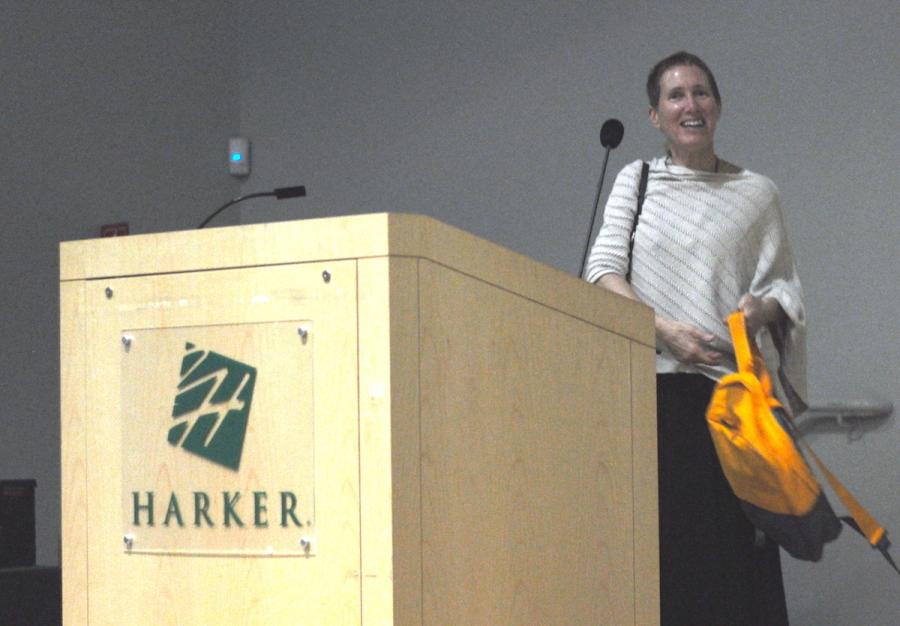Archaeologist Jodi Magness presents groundbreaking finds
Archaeologist Jodi Magness speaks to the students in Nichols Aditorium about her great finds. Donna Gilbert, who organized Dr. Mangess’s visit, used to be a student of the archaeologist.
Archaeologist and professor Dr. Jodi Magness spoke to the Upper School community today about her groundbreaking and unpublished late-Roman synagogue excavations in Huqoq, Israel.
From the first month of excavation, the study has been “serendipitous,” revealing the second-ever synagogue mosaic of the Old Testament hero Samson. Dr. Magness detailed the process of selecting the study’s location, assembling a team of specialists, and excavating the site.
“You have to be really careful,” Dr. Magness said, describing the site selection as an “educated guess.” “It’s not like formal scientific research, because you don’t have a repeatable experiment. You don’t get a do-over.”
Dr. Magness, a current archaeology professor at the University of North Carolina at Chapel Hill, specializes in ancient synagogues and architecture of Palestine during the Roman, Byzantine and early Islamic periods.
“No pictures, please,” she said, before revealing her team’s major mosaic findings from this summer, which are currently being compiled into a research paper.
Dr. Magness’s motivations for archaeological study began at a young age with a childhood interest.
“I wanted to be an archaeologist since I was 12.” she said. “I had the usual childhood fascination with dinosaurs. I was going to Girl Scout camp, too, and finding fossils of shells. Anyway, it all sort of pulled together and ever since then I wanted to be an archaeologist.”
Donna Gilbert, History and Social Science Department Chair and Dr. Magness’s thesis advisee, organized the archaeologist’s visit.
“She was a fantastic teacher,” Gilbert said. “I’ve always wondered about what she was doing. I actually looked her up and found out that she was doing some incredible new work. I thought it would be really interesting to try and get her to come and talk at our school.”
The presentation was largely attended by history students and architecture enthusiasts.
“Over the months, we’ve studied quite a few different pieces and analyzed their canonical significance in western art history,” AP Art History student Maya Nandakumar (12) said. “It was compelling to hear Dr. Magness speak about the process of actually determining the relevance of such works.”
Dr. Magness will continue the Huqoq dig with UNC-Chapel Hill students this summer. Future trips are dependent on funding for the $170,000-per-year project.
Emma Yu (9) is a reporter for The Winged Post. In her free time, she usually draws, surfs the internet, and hopes for no tests in the upcoming weeks of...


















![“[Building nerf blasters] became this outlet of creativity for me that hasn't been matched by anything else. The process [of] making a build complete to your desire is such a painstakingly difficult process, but I've had to learn from [the skills needed from] soldering to proper painting. There's so many different options for everything, if you think about it, it exists. The best part is [that] if it doesn't exist, you can build it yourself," Ishaan Parate said.](https://harkeraquila.com/wp-content/uploads/2022/08/DSC_8149-900x604.jpg)




![“When I came into high school, I was ready to be a follower. But DECA was a game changer for me. It helped me overcome my fear of public speaking, and it's played such a major role in who I've become today. To be able to successfully lead a chapter of 150 students, an officer team and be one of the upperclassmen I once really admired is something I'm [really] proud of,” Anvitha Tummala ('21) said.](https://harkeraquila.com/wp-content/uploads/2021/07/Screen-Shot-2021-07-25-at-9.50.05-AM-900x594.png)







![“I think getting up in the morning and having a sense of purpose [is exciting]. I think without a certain amount of drive, life is kind of obsolete and mundane, and I think having that every single day is what makes each day unique and kind of makes life exciting,” Neymika Jain (12) said.](https://harkeraquila.com/wp-content/uploads/2017/06/Screen-Shot-2017-06-03-at-4.54.16-PM.png)








![“My slogan is ‘slow feet, don’t eat, and I’m hungry.’ You need to run fast to get where you are–you aren't going to get those championships if you aren't fast,” Angel Cervantes (12) said. “I want to do well in school on my tests and in track and win championships for my team. I live by that, [and] I can do that anywhere: in the classroom or on the field.”](https://harkeraquila.com/wp-content/uploads/2018/06/DSC5146-900x601.jpg)
![“[Volleyball has] taught me how to fall correctly, and another thing it taught is that you don’t have to be the best at something to be good at it. If you just hit the ball in a smart way, then it still scores points and you’re good at it. You could be a background player and still make a much bigger impact on the team than you would think,” Anya Gert (’20) said.](https://harkeraquila.com/wp-content/uploads/2020/06/AnnaGert_JinTuan_HoHPhotoEdited-600x900.jpeg)

![“I'm not nearly there yet, but [my confidence has] definitely been getting better since I was pretty shy and timid coming into Harker my freshman year. I know that there's a lot of people that are really confident in what they do, and I really admire them. Everyone's so driven and that has really pushed me to kind of try to find my own place in high school and be more confident,” Alyssa Huang (’20) said.](https://harkeraquila.com/wp-content/uploads/2020/06/AlyssaHuang_EmilyChen_HoHPhoto-900x749.jpeg)



